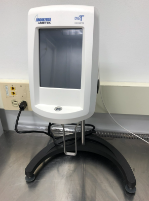Viscometry: Difference between revisions
(The image is now showing up correctly and I have begun adding text to the page. The SOP is linked above the viscometer image.) |
(I have started the theory section.) |
||
| Line 10: | Line 10: | ||
|'''Spec 2''': Details | |'''Spec 2''': Details | ||
|} | |} | ||
== | ==Theory== | ||
Viscosity is a | Viscosity is a quanity that describes the resistance to flow of a fluid. Flowing liquids have layers, and the friction between the layers contributes to the measured viscosity value. The more resistance between layers, the more force is required to move the fluid. For example, if one were to attempt to stir a spoon in a jar of honey, more force would be required to move the honey out of the way of the spoon than would be required to move the same spoon through a jar of water. Honey has a greater viscosity than water. Viscosity is calculated using the quantities of shear stress and shear rate. Shear stress is defined as force divided by area, and is in this case a the measured amount of force per area required to cause the fluid to move. Shear rate is the speed of the fluid caused by the force. As shown in the equation below, viscosity is the shear stress divided by the shear rate. | ||
== | ==Functionality== | ||
The viscometer rotates a spindle submerged in the fluid of interest through a spring, which measures the drag caused by the fluid. Factors determining the viscosity measurement are the spindle being used (chosen for its size), the container (this viscometer is calibrated for 600 milliliter low-form Griffin beakers), and the speed of the spindle. Prior to starting a test, the user can select a combination of spindle and rotation speed that best suits their needs and the expected viscosity of the fluid being measured. The viscometer will automatically update the maximum viscosity it can accurately measure with the selected parameters as the user changes the options (i.e. selecting a smaller spindle and/or lowering the speed will increase the range). | The viscometer rotates a spindle submerged in the fluid of interest through a spring, which measures the drag caused by the fluid. Factors determining the viscosity measurement are the spindle being used (chosen for its size), the container (this viscometer is calibrated for 600 milliliter low-form Griffin beakers), and the speed of the spindle. Prior to starting a test, the user can select a combination of spindle and rotation speed that best suits their needs and the expected viscosity of the fluid being measured. The viscometer will automatically update the maximum viscosity it can accurately measure with the selected parameters as the user changes the options (i.e. selecting a smaller spindle and/or lowering the speed will increase the range). | ||
===Subsection 1=== | ===Subsection 1=== | ||
Formulae or sidenotes about theory can be placed in subsections. (ex. XRD <math>\rightarrow</math> Bragg's Law) | Formulae or sidenotes about theory can be placed in subsections. (ex. XRD <math>\rightarrow</math> Bragg's Law) | ||
Revision as of 17:00, 13 October 2022
| Brookfield DV2T Viscometer [SOP] |
|---|
| Measurement Range: 15-6,000,000 centipoise (cP) |
| Spec 2: Details |
Theory
Viscosity is a quanity that describes the resistance to flow of a fluid. Flowing liquids have layers, and the friction between the layers contributes to the measured viscosity value. The more resistance between layers, the more force is required to move the fluid. For example, if one were to attempt to stir a spoon in a jar of honey, more force would be required to move the honey out of the way of the spoon than would be required to move the same spoon through a jar of water. Honey has a greater viscosity than water. Viscosity is calculated using the quantities of shear stress and shear rate. Shear stress is defined as force divided by area, and is in this case a the measured amount of force per area required to cause the fluid to move. Shear rate is the speed of the fluid caused by the force. As shown in the equation below, viscosity is the shear stress divided by the shear rate.
Functionality
The viscometer rotates a spindle submerged in the fluid of interest through a spring, which measures the drag caused by the fluid. Factors determining the viscosity measurement are the spindle being used (chosen for its size), the container (this viscometer is calibrated for 600 milliliter low-form Griffin beakers), and the speed of the spindle. Prior to starting a test, the user can select a combination of spindle and rotation speed that best suits their needs and the expected viscosity of the fluid being measured. The viscometer will automatically update the maximum viscosity it can accurately measure with the selected parameters as the user changes the options (i.e. selecting a smaller spindle and/or lowering the speed will increase the range).
Subsection 1
Formulae or sidenotes about theory can be placed in subsections. (ex. XRD [math]\displaystyle{ \rightarrow }[/math] Bragg's Law)
Subsection 2
- A LaTeX extension is available on the MILL Wiki.
- Simply enclose your LaTeX in
<math>...</math>
- Simply enclose your LaTeX in
Subsubsection
- To display a monospaced code textbox, use
<code>...</code>- To remove Wiki formatting, use
<nowiki>...</nowiki>
- To remove Wiki formatting, use
Extras
Create a new page
If the page already exists, this will redirect you to the source editor.
